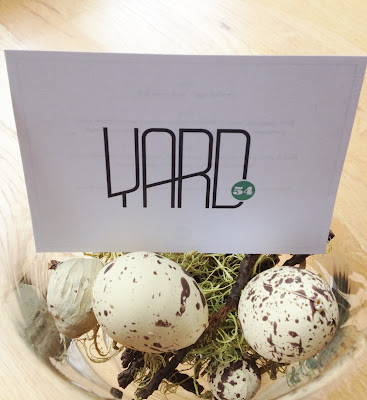The notion of an underground brunch club is a
brilliant niche to tap into. Underground supper clubs have been a rage of sorts
around the Atlanta food scene for a few years, undoubtedly due to the rise in
social media networking. The brainchild of James Martin of The Burger Coalition and Twelve Supper and Chef Rawle Fraser of Muss and Turner's and previously Commune Supper Club, Yard 54 is a brunch-based twist on the pop-up underground restaurant that brings together people and fresh ingredients to one of Atlanta’s great neighborhoods. The meals are limited to 6-8 people and are intended to be as much about making new acquaintances and opening new conversations as they are about new tastes.
 |
| Print from TwoCardinalDay |
This past weekend Yard 54 had a soft launch at the
home of Chef Rawle Fraser in Reynoldstown. The awkwardness of entering an
unknown experience quickly passed as guests were handed tiny Mason jars of bubbly.
Conversation flowed much like the prosecco as the collection of six guests
arrived and mingled. Yard 54 always begins with a reception until all guests
have arrived.
Almost immediately talk turned to local food. A
train rushed by and we discussed the Yard 54 logo. “Yard” reflects fresh--the
freshest ingredients possible, perhaps from one’s yard. The lettering
emblematizes the nearby train yard. "54" references the address of Chef Rawle's home on the corner of Wylie and Chester. Such careful attention to detail heightened
interest in the forthcoming menu.
When the bowl of Nieman Ranch sweet tea braised pork cheeks was placed before each diner, heads bowed to take in the wafting but subtle smokiness emanating from the smoked Logan Turnpike grits. It was at this moment that one of the perks of an intimate brunch experience was evident. Chef Rawle heard us asking "I wonder how he smoked them?' and gave us step by step instructions on how to recreate them. Bowls were soon emptied of the tender pork, smoky grits and jus, lacinato kale chips, and vanilla pear compote. This dish was a triumph. When asked about pairings, Chef Rawle noted a favorite book, The Flavor Bible, as the most helpful resource for unexpected flavor pairings. He wants to be able to explore and introduce patrons to new and different things, perhaps with offal or under utilized cuts of meat with Yard 54.
Our sweet course was a beauty: Lemon bar with raspberry sauce, house made fromage blanc, and lavender honey. The individual ingredients were tasty and fresh and once combined, proved heavenly. The perfect buttery crust really stood out. Again, Chef Rawle stepped from the kitchen and went through the steps of how he made the fromage blanc and then his technique used when infusing honey with lavender.
Yard 54 launches April 20th. To sign up for the mailing list go here or email eatatyard54@gmail.com. You can also find Yard 54 on Facebook and Twitter (@Yard54). Expect interesting and original menus (never eggs and sausage) and a guaranteed convivial atmosphere. Also expect to build a relationship with who is cooking your food. Yard 54 will alternate between coursed menus and family style menus. Sporadically they will do dinners as well but brunch will be the focus initially. Yard 54 wishes to bring back communal conversation to dining with the freshest ingredients and sometimes unconventional dishes in an intimate atmosphere with accessibility to the chef while he is prepairing courses.















